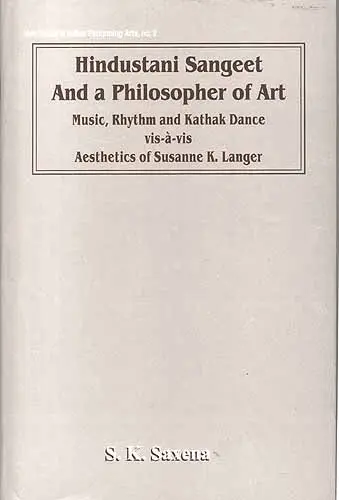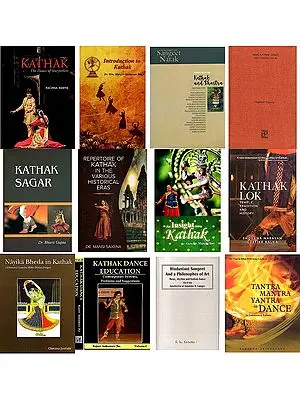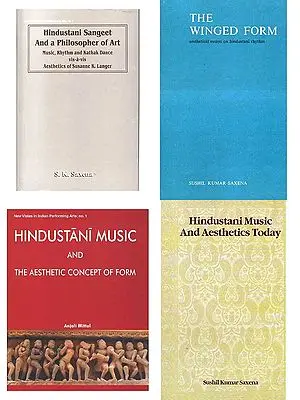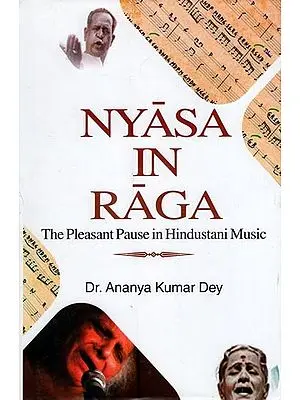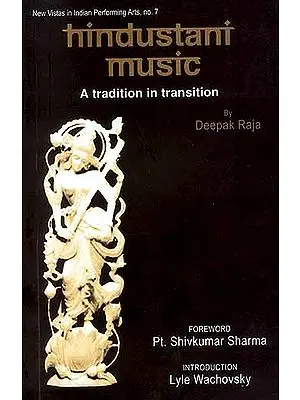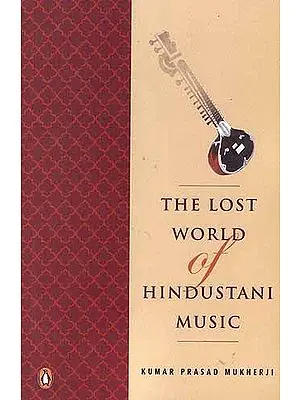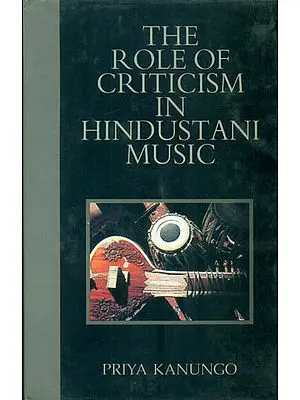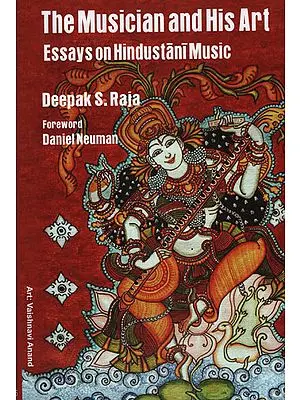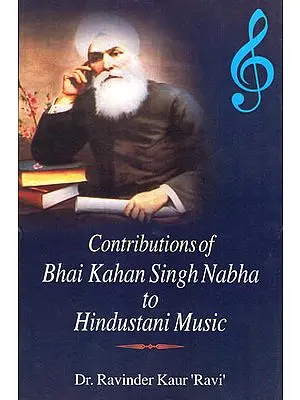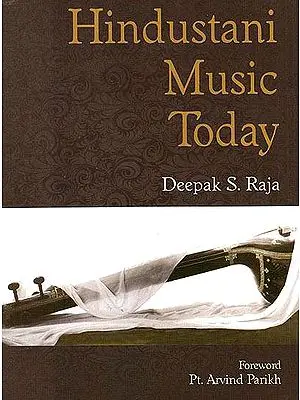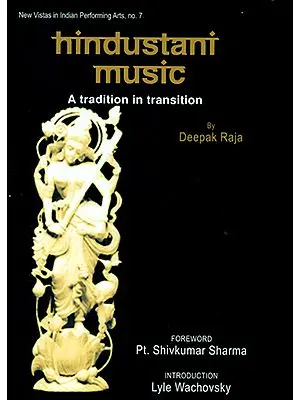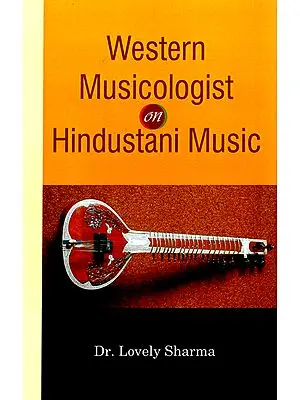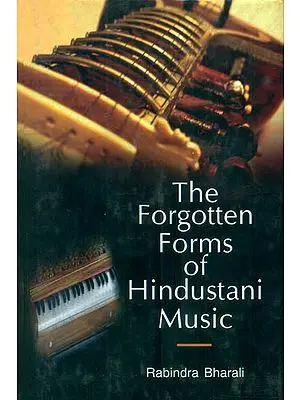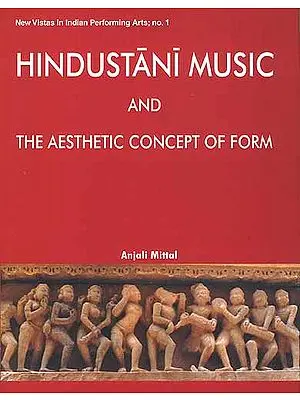Hindustani Sangeet And a Philosophy of Art: Music, Rhythm and Kathak Dance vis-à-vis Aesthetics of Susanne K. Langer
| Specifications |
| Publisher: D. K. Printworld Pvt. Ltd. | |
| Author: S. K. Saxena | |
| Language: English | |
| Pages: 383 (Color Illus: 50) | |
| Cover: Hardcover | |
| 8.9" X 5.8" | |
| Weight 730 gm | |
| Edition: 2013 | |
| ISBN: 9788124601808 | |
| IDD158 |
| Delivery and Return Policies |
| Ships in 1-3 days | |
| Returns and Exchanges accepted with 7 days | |
| Free Delivery |
About the Author:
Sushil Kumar Saxena (b. 1920) retired in 1986 as Professor of Philosophy from the University of Delhi where he started the teaching of aesthetics at the postgraduate level in 1964, and continued doing it till his retirement. The very first of the half a dozen books that he has published so far, Studies in the Metaphysics of Bradley (1967), had the distinction of being included in George Allen and Unwin's Muirhead Library series of philosophical works. Today, however, he is better known as probably the country's only professionally trained philosopher who has been writing on Hindustani music, rhythm, and Kathak dance for the last fifty years, fairly regularly, and mostly in the way of contemporary philosophical aesthetics.
Currently, as a senior Fellow of the Indian Council of Philosophical Research, Prof. Saxena is engaged in writing a comprehensive book on the arts in India as they relate to aesthetics today.
About the Book:
The book is decidedly the very first of its kind. It seeks to weigh some basic facts and concepts of Hindustani Sangeet (music, rhythm, and Kathak dance) against the art theories of Susanne K. Lange, an eminent aesthetician of the recent past; but nowhere without meticulous attention to the text of her writings.
The expression theory of art has for long dominated the history of aesthetics. At the hand of Langer, however, the theory takes a new turn. She conceives of art not as a direct self-expression of the artist's immediate affective state, but as a symbolic expression of his knowledge of what she terms variously as felt life, sentience, or forms of feeling. Drawing freely upon examples from the region of Hindustani Sangeet, the present book accepts Langer's protest against the popular view of artistic expression, but contends that there is a good deal in our music and dance which has nothing to do with feeling, and is admired simply because of its sweetness, clarity, shapeliness, and accordance with grammatical norms.
In the chapter on music, while discussing Langer's emphasis on 'commanding form' in a total performance, the author proposes a quite new definition of raga which seeks to integrate the various points in its traditional characterizations. The third chapter too, which deals with Langer's view of rhythm, is not merely explanatory, but ventures to propose a fresh and fairly defensible definition of rhythm.
The closing chapter, devoted to dance, not only essays to meet some key objections to Langer's writing on this art, but clarifies some atypical language that she uses in this context: apparition of vial power; the dynamic image; virtual realities; and the created, 'superhuman' dance-personality.
But perhaps the two most striking features of the book are: first a lucid exposition of the essential of Langer's aesthetics in the opening chapter; and, second, abounding illustrative reference to Hindustani Sangeet
Internationalism in aesthetics is a growing demand of the day, and work in this direction has already begun paying dividends. I say so on the basis of my own experience. My studies in philosophical aesthetics began in 1964, when I was asked to start the teaching of this young and very promising discipline to postgraduate students of my university, that is, the University of Delhi. Ever since that year I have tried to make a close study of the basic writings of some of the greatest aestheticians of the West with a threefold purpose. First, I wanted to get familiar with their analytic ways of looking at problems relating to art, - ways which are necessary for authentic understanding, and so also for avoiding obfuscatory metaphysical jargon to which we in India have freely resorted in our traditional, scholarly concern with the arts, with not very happy results. Second, with the help of this supplement to my own habits of thinking, my aim has also been to gain a better understanding of Hindustani music, rhythm, and Kathak dance - three aspects of Sangeet with which I have been quite actively, and not merely theoretically concerned for long. Thirdly, I have been keen to determine how the leading Western theories of art relate to our own music and dance.
None of these aims has remained quite unattained by the work I have already published. My first step in this direction was my little book on rhythm, The Winged Form: Aesthetical Essays on Hindustani Rhythm, brought out by our central Sangeet Natak Akademi in 1979. It is admittedly a mere primer. But, as an analytic study of Hindustani rhythm taken generally, and not only of the idiom and repertoire of any particular gharana (traditional family-school), it has neither any precedent, nor even a rough analogue so far. I think I can fairly say the same of my second attempt in the way of contemporary aesthetics, namely, Swinging Syllables - Aesthetics of Kathak Dance (Sangeet Natak Akademi, 1991). To the best of my knowledge, it is the first ever analytic study of an important classical dance of India; and it too is yet to stimulate similar work in respect of our other dance-forms, all alike beautiful and open to aesthetic analysis. A subsequent work, an essay in both understanding and evaluation, has also gratified me. Art and Philosophy - Seven Aestheticians (Indian Council of Philosophical Research, New Delhi, 1994) is, in fact, my first sustained attempt to look at some leading aestheticians of the West - from Benedetto Croce to L.A. Reid - not merely in the context of their original writings, but in relation to the three facets of sangeet I have distinguished, and have been keenly interested in for a number of years. Luckily, this recent book has been liked by some top aestheticians of the day. Jerome Stolnitz, sometime President of the American Society for Aesthetics, believes it is 'admirably comprehensive [and] uniformly thoughtful'; and adds that 'there is nothing in the current literature that does the same thing in the same way'. This has surely encouraged me to keep working on the lines I have chosen.
The present book, however, follows a path which is a little different, and is perhaps of direct value to us in India. It is a detailed attempt to interpret and examine a fair part of the aesthetics of Susanne K. Langer, an important 'systematic' aesthetician of recent times, in the light of the evidence of our Hindustani music, rhythm and Kathak dance. I indeed expect this book to enable us to adjudge her work a little more thoughtfully than we have done so far; and to improve our own understanding of the three allied arts I propose to focus on, namely, music, rhythm, and dance.
What lends aesthetic substance to this work is, in the main, my fellowship of fifty long years with Hindustani sangeet in a multiple capacity, that is, as a rasika, critic and as an aesthetician; and also as a composer of sorts. At quite a few places in this work, I have drawn upon my 'critical' write-ups contributed (since 1950) to the following: The Hindustan Times, The Pioneer, Asian Age, and Sruti (Madras) for which I still write as a contributing editor. I have also availed of some of my essays published (and debated) in leading Western journals; and, above all, in Sangeet Natak, official journal of our central Sangeet Natak Akademi which has all along been very helpful to me. Further, the recordings of some select musicians that I have done in the last few years on behalf of the Akademi and the Indira Gandhi National Centre for the Arts have also provided some good material for the present work.
But I see it clearly that the basic impulse to take to philosophical aesthetics as a lifelong commitment has come from my careful and repeated reading of the works of Susanne K. Langer; and that, if not quite openly, the fillip to go on has been provided, in a measure, by her following moving and reassuring words in a letter written to me more than eighteen years ago (30.4.1982):
I am sorry there has been such a long delay in thanking you for sending me your book [Aesthetical Essays, 1981] which I have read as far as my failing eyesight has allowed. Among all the reactions to my own ideas which I received, yours has been one of the most gratifying. Unlike most of the others who have put their previous ideas into my words, I feel that you have understood what I have actually said. Perhaps your Indian background is more conducive to understanding than our Western habits of thought. I am sorry that we have never met each other.
Therefore, it is not without reason that I have dedicated this book to her memory. The sense that I am deeply indebted to her work is also the reason why my disagreement with her views, which recurs freely in this book, has in every case come about after very close attention to the text of her books; and perhaps never without a touch of regret.
To the other dedicatee, Ustad Rahirnuddin Khan Dagar, I am just as indebted. He was a consummate alapiya, and the first to open my eyes to the glories of the severely 'pure' in Indian vocal music, that is, of alapa which needs. neither rhythm nor any words to spellbind the listener. In respect of sheer fineness of musical utterance and impact, I have not come across anything preferable to alapa of this maestro of the Dagar gharana.
But as I say so, I cannot help recalling, very gratefully, how much I owe to the following artistes as well, for making me see some of the subtlest charms of the different aspects of our sangeet: Ustads Chand Khan, Hilal Ahmad, and Nasir Ahmad (khyal-gayaki of Delhi gharana); my brother, Prof. Sudhir Kumar Saxena and Ustad Chharnma Khan (tabla-rhythm); and Nrtyacarya Narayan Prasad and Akademi Award winner Rani Kamaa (Kathak Dance).
All this, however, could not see the light of day without the kindly co-operation of my publishers, D.K. Printworld (P) Ltd. They have taken pains to ensure correct printing and also to make the book look good. Further, to lessen the strain on my ageing eyes, in the first two proofs of the manuscript submitted to me, they used a bigger font than the one which appears in the book. This has touched me deeply.
| Preface | vii | |
| Acknowledgements | xi | |
| 1. | Langer's Theory of Art: Some Essentials | 1 |
| 2. | Of Music: Langer and an Indian genre | 103 |
| 3. |
Imaging Time in Music: Langer and Hindustani Rhythm |
217 |
| 4. | Magic in Movement: Langer and Kathak Dance | 281 |
| Bibliography | 369 | |
| Index | 371 |
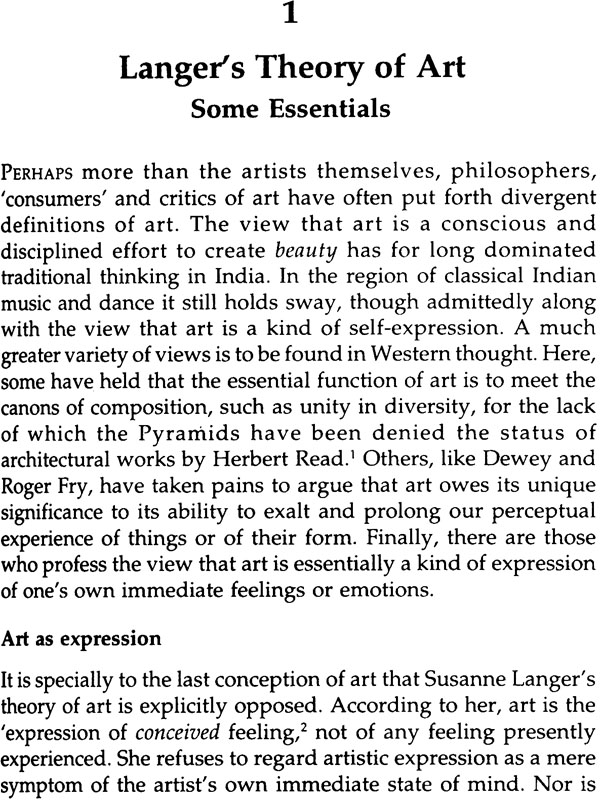
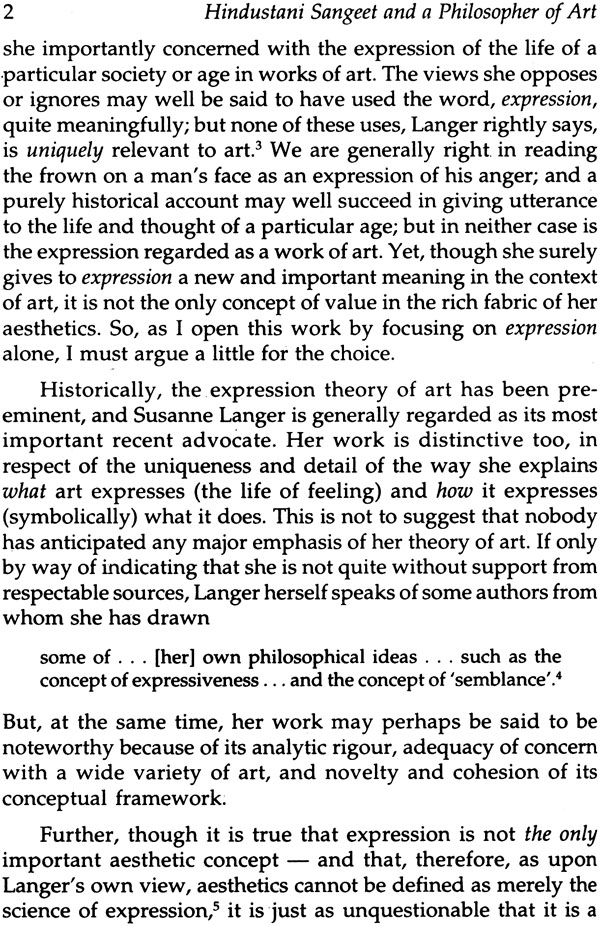
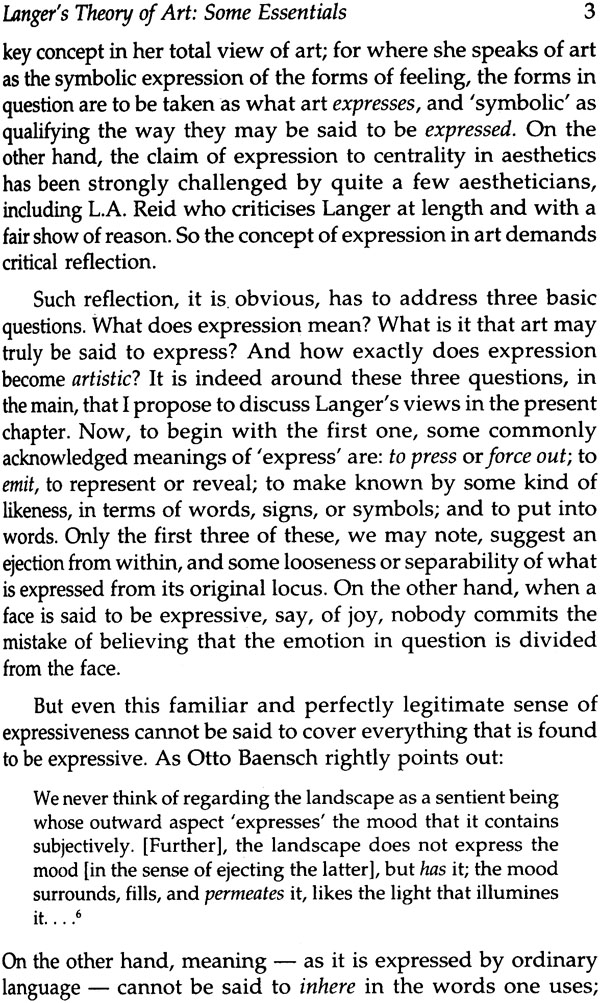
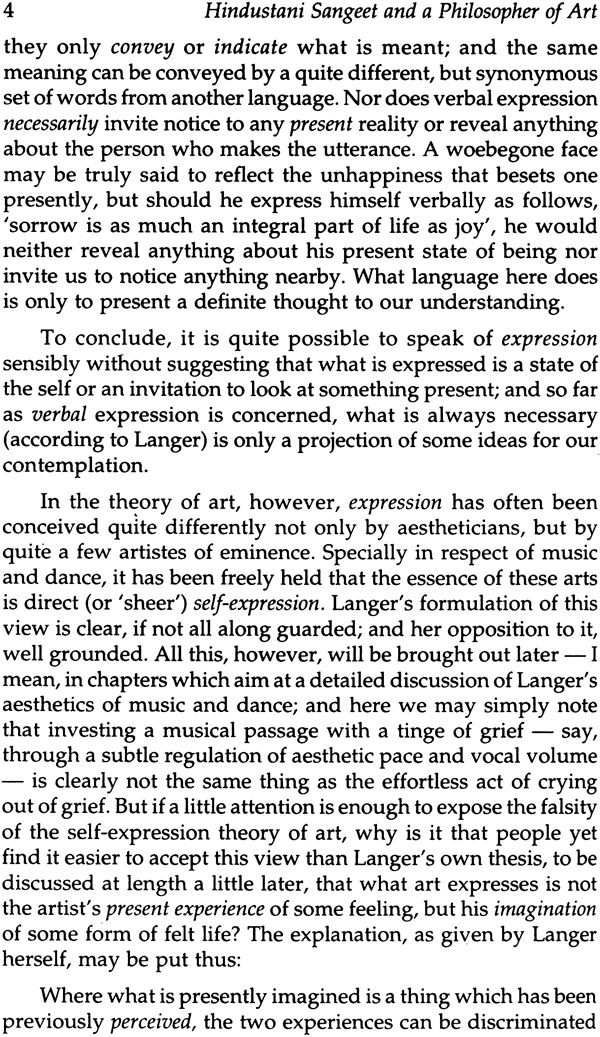
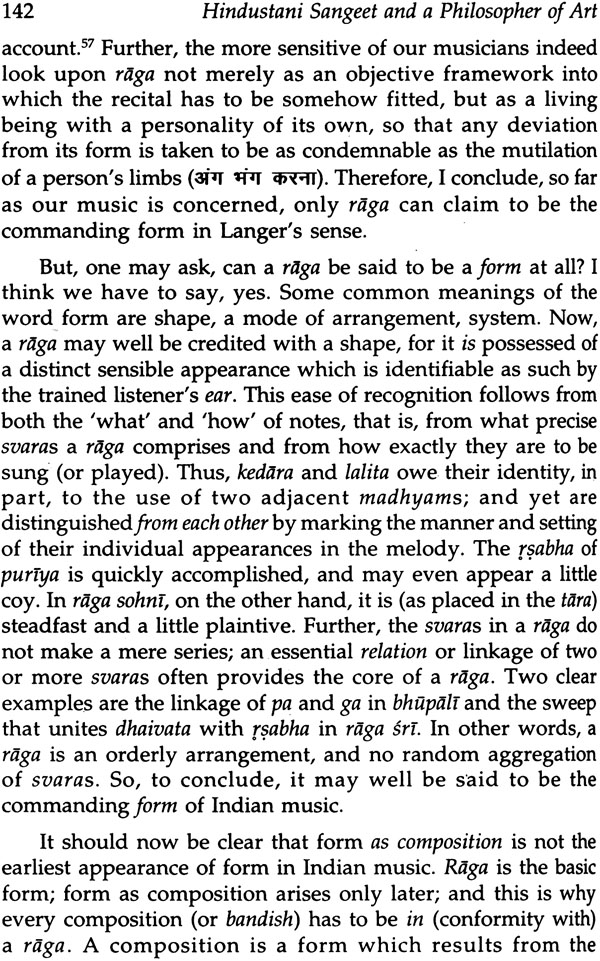
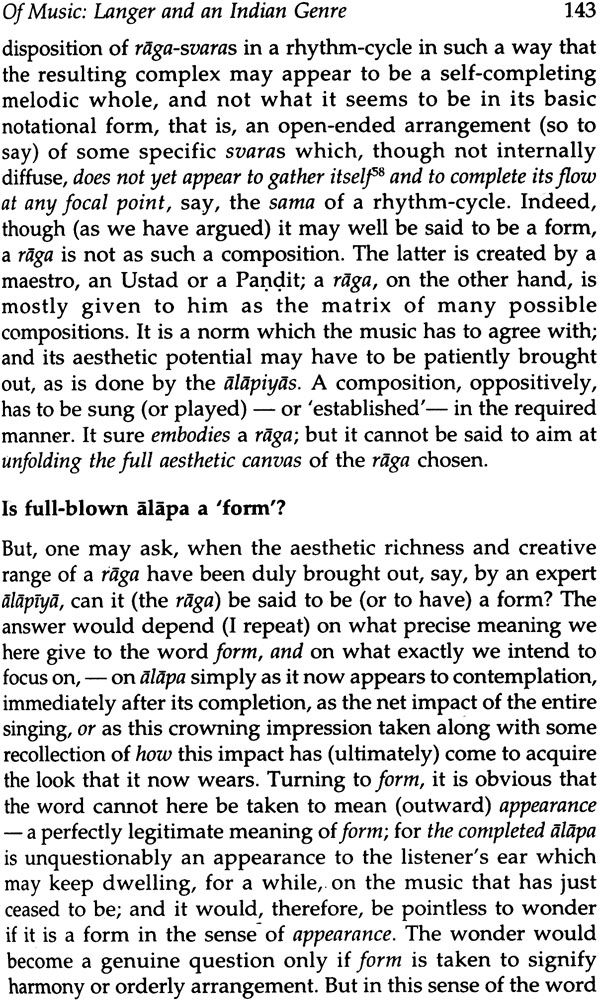
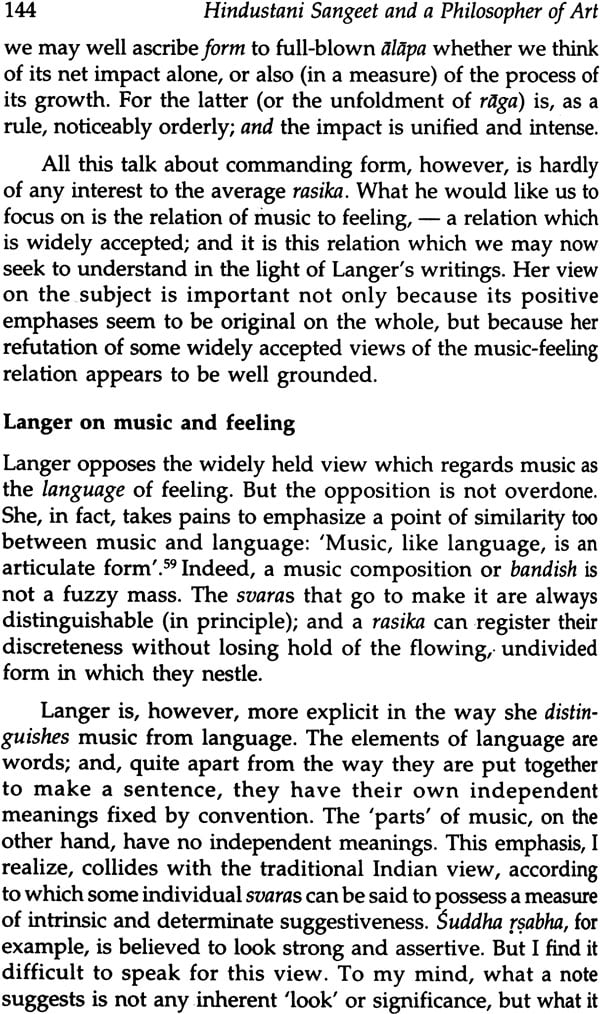
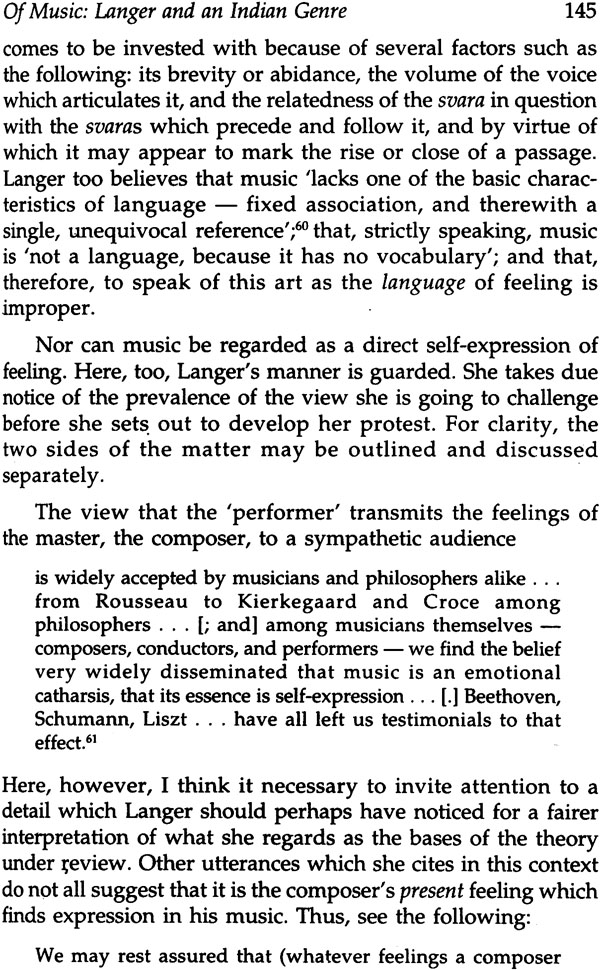
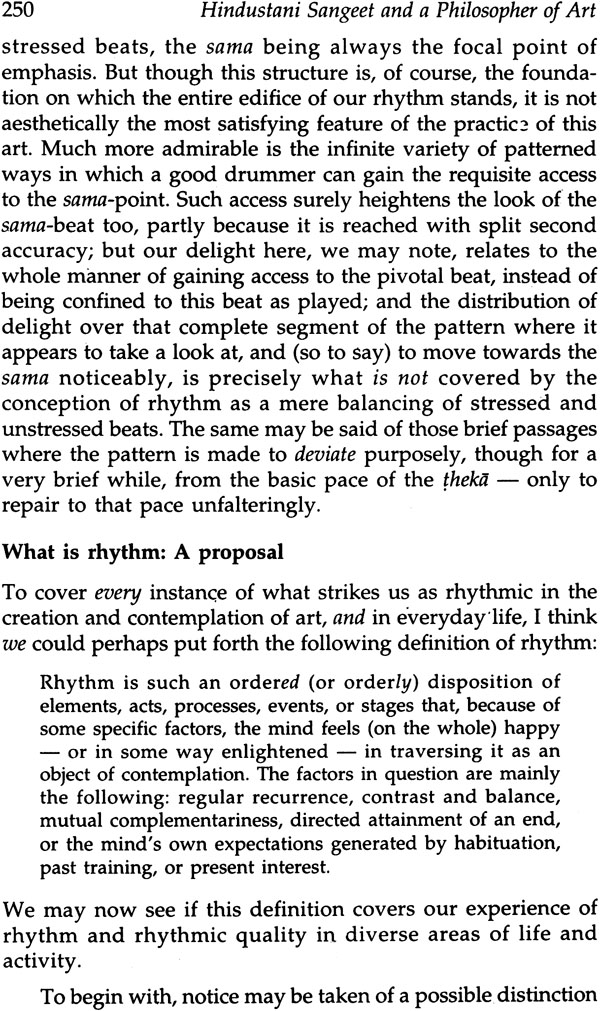
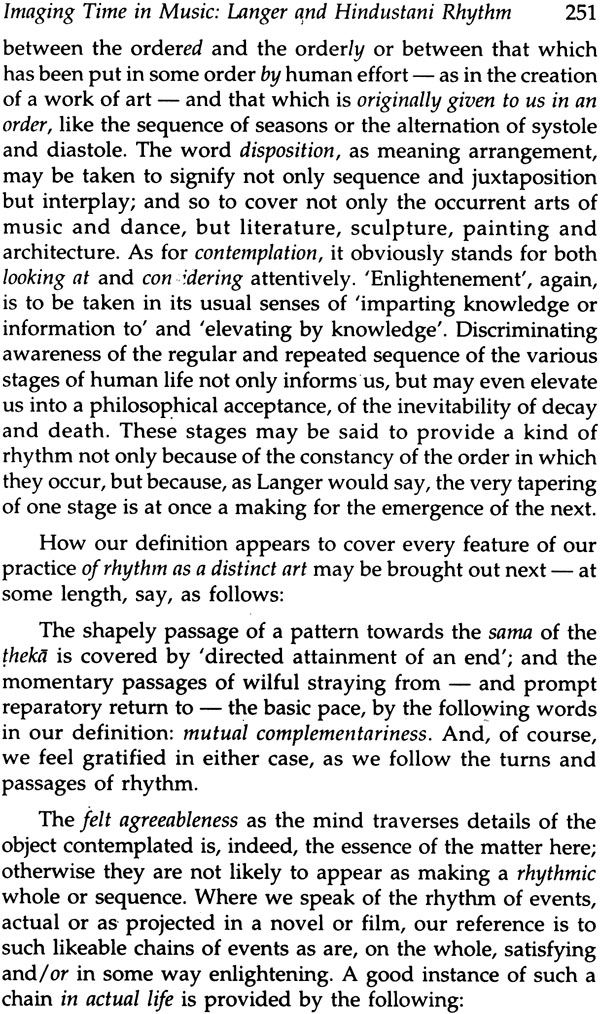
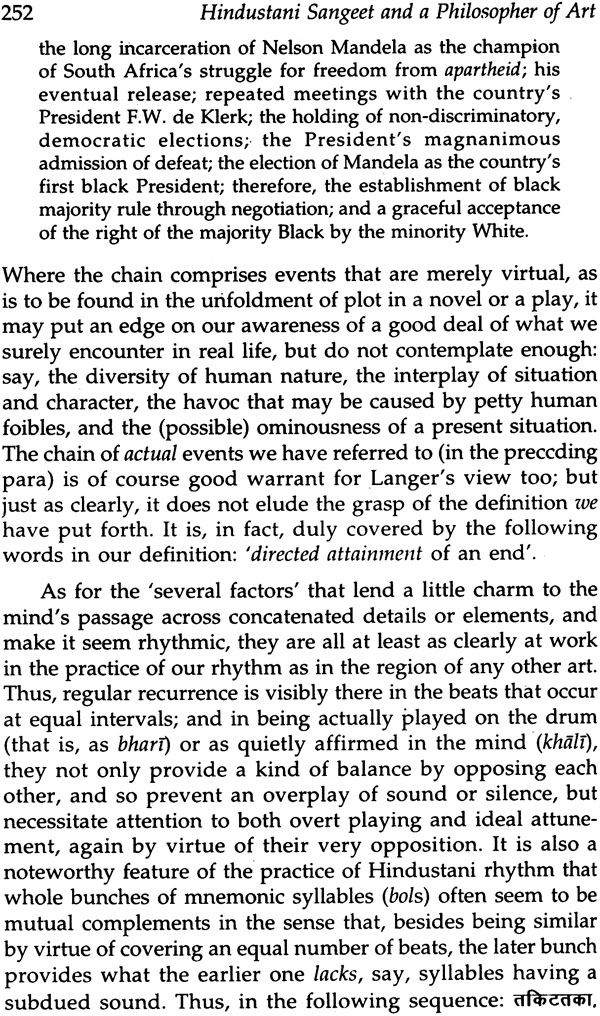
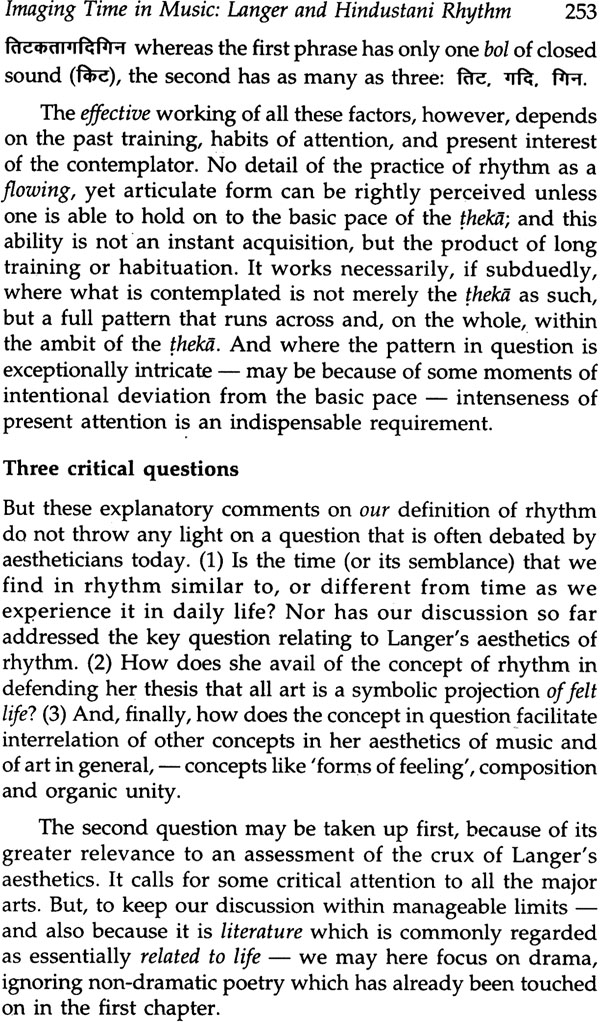
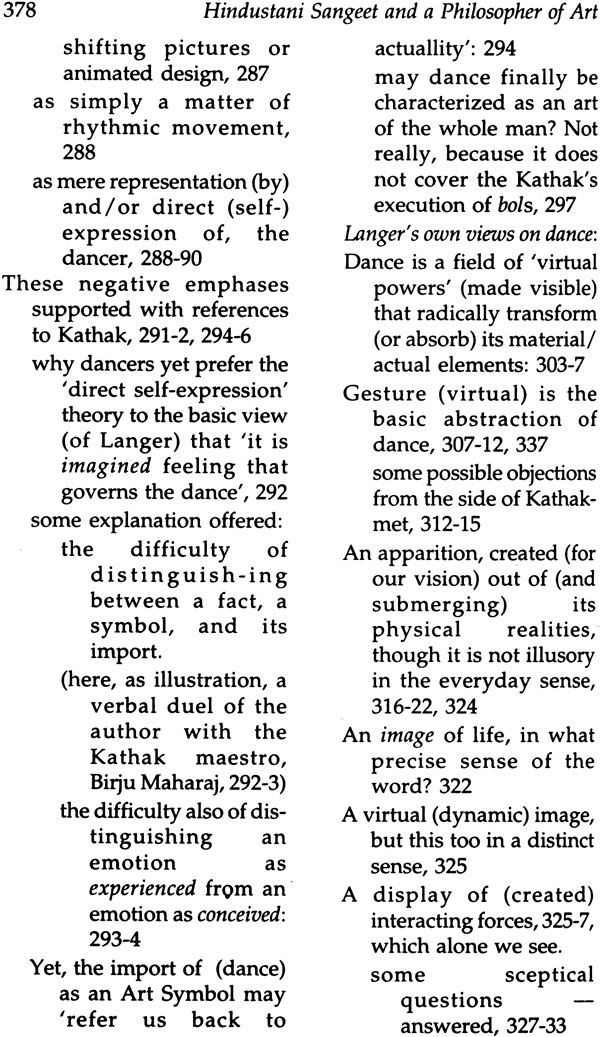
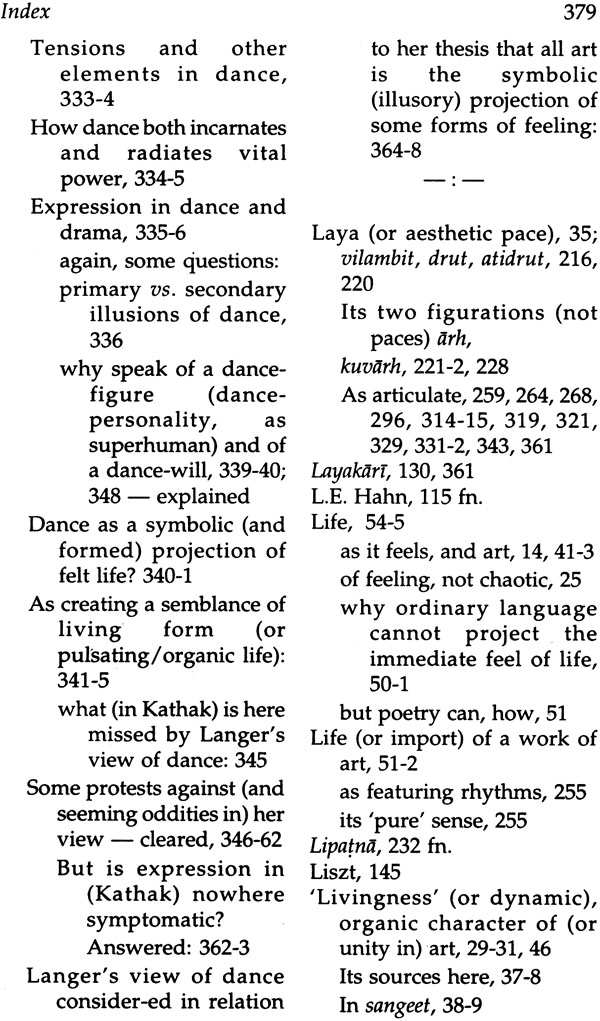
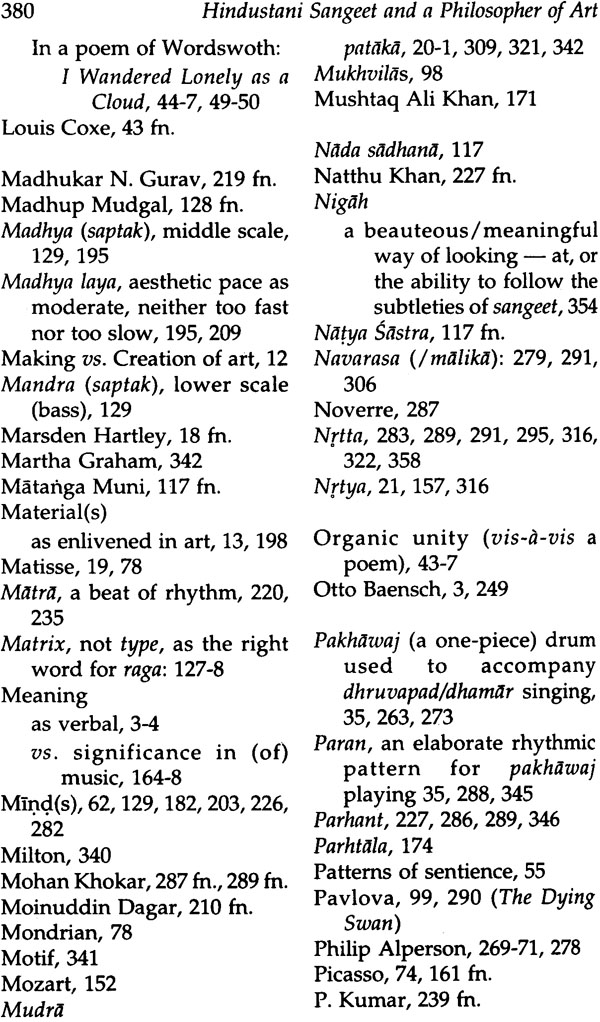
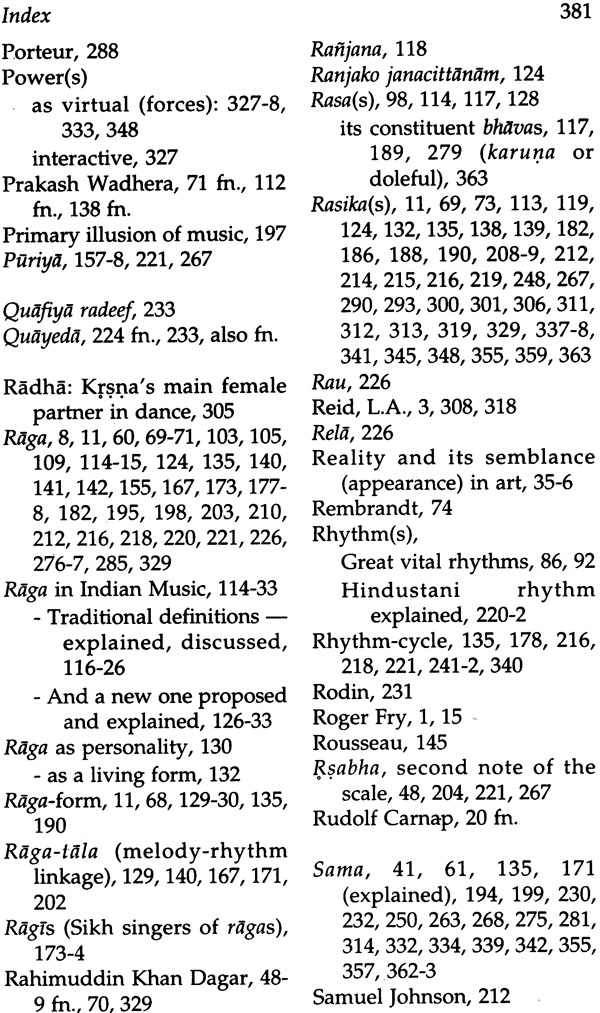
-
Q. What locations do you deliver to ?A. Exotic India delivers orders to all countries having diplomatic relations with India.
-
Q. Do you offer free shipping ?A. Exotic India offers free shipping on all orders of value of $30 USD or more.
-
Q. Can I return the book?A. All returns must be postmarked within seven (7) days of the delivery date. All returned items must be in new and unused condition, with all original tags and labels attached. To know more please view our return policy
-
Q. Do you offer express shipping ?A. Yes, we do have a chargeable express shipping facility available. You can select express shipping while checking out on the website.
-
Q. I accidentally entered wrong delivery address, can I change the address ?A. Delivery addresses can only be changed only incase the order has not been shipped yet. Incase of an address change, you can reach us at help@exoticindia.com
-
Q. How do I track my order ?A. You can track your orders simply entering your order number through here or through your past orders if you are signed in on the website.
-
Q. How can I cancel an order ?A. An order can only be cancelled if it has not been shipped. To cancel an order, kindly reach out to us through help@exoticindia.com.
